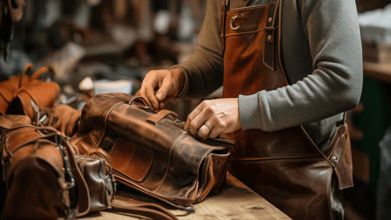- panoramicexports
- December 20, 2024

India vs China: Leather Goods Manufacturing Success
Discover why India outperforms China in leather goods manufacturing. Explore India’s historical expertise, superior leather quality, competitive labor costs, and strong craftsmanship traditions that contribute to its thriving leather industry.
Historical Perspective of Leather Craft in India
Registering for the IHGF Delhi Fair is a simple process that can be done online. EPCH provides a dedicated The rich heritage of leather crafting in India dates back to ancient times, with roots that can be traced to some of the earliest civilizations. Historical records and archaeological findings reveal that leather goods were utilized in various forms by early Indian communities, serving needs ranging from clothing to tools and ornamental items. This long-standing tradition has evolved through the centuries, influenced by diverse cultural interactions and regional variations, thereby contributing to a distinctive craftsmanship that India is renowned for today.
One of the significant factors that underscores India’s proficiency in leather goods is the depth of traditional techniques that have been meticulously passed down through generations. Artisans in India employ age-old methods, including vegetable tanning, which not only preserves the environment but also enhances the quality of the leather. This craft is deeply embedded in the cultural fabric of various regions, with each locality boasting its own distinct style and design aesthetics. For instance, the intricate embroidery of Punjab, the vibrant patterns from Rajasthan, and the exquisite hand-painted leather from Kerala are just a few examples of how regional expertise enriches the leather goods sector.
In contrast to India, the historical narrative of leather production in China highlights mass production techniques that emerged later. While China also boasts a significant leather industry, its focus has often been on quantity rather than quality. This emphasis on larger outputs sometimes compromises the artistic expression and uniqueness that characterize Indian leather goods. By examining the historical lineage of leather craftsmanship in both countries, it becomes evident that India’s legacy is not only about producing leather items but also about fostering creativity and meticulous artistry, giving Indian leather goods a competitive advantage in both local and global markets.
Quality and Craftsmanship: A Comparative Analysis
The leather goods industry is significantly influenced by the quality of raw materials and the craftsmanship involved in production. India has garnered an esteemed reputation in the global market due to its exceptional leather quality and meticulous handcrafted techniques. The rich heritage of leather craftsmanship in India is supported by the availability of superior raw materials sourced from indigenous livestock. Indian artisans utilize locally-sourced leather known for its durability, softness, and aesthetic appeal, which distinguishes Indian leather products from those produced in other countries, including China.
In contrast, the Chinese leather industry often relies on mass production techniques, compromising on the quality of the leather used as well as the overall craftsmanship. While China has made strides in manufacturing efficiency, these have often come at the expense of artisanal skill. The focus on quantity over quality results in leather goods that lack the detailing and superior finish inherent in Indian products. The slower, more traditional methods employed by Indian artisans allow for greater attention to detail, ensuring that each piece reflects the skill and dedication of its maker.
Renowned Indian leather products, such as handbags from Jaipur and handcrafted footwear from Kanpur, demonstrate this commitment to quality and craftsmanship. These products are characterized by intricate designs, vibrant colors, and a durability that often surpasses their Chinese counterparts. Moreover, the usage of natural dyes and eco-friendly tanning processes further enriches the appeal of Indian leather goods. Due to this emphasis on fine craftsmanship and sustainability, Indian leather products often command a higher price in international markets, reflecting their superior quality.
Meanwhile, the Chinese leather industry faces challenges, including a growing emphasis on sustainability and ethical production practices. As global consumers become more discerning regarding the quality and craftsmanship of leather goods, the comparative advantages of Indian leather may continue to rise, reinforcing India’s position as a leader in this sector.
Sustainability and Ethical Practices in Indian Leather Industry
The Indian leather industry is gradually transforming to prioritize sustainability and ethical practices, responding to both consumer demand and global trends. Manufacturers in India have recognized the importance of adopting eco-friendly processes in their operations, which ultimately enhance the quality of leather goods produced. This shift includes the use of vegetable tanning methods and minimizing water consumption during production. Moreover, many Indian leather producers are actively incorporating renewable energy into their manufacturing processes, creating an eco-conscious approach that appeals to environmentally aware consumers.
In contrast, the leather industry in China has faced criticism for lax environmental regulations and questionable labor rights practices. Reports indicate that some manufacturers in China struggle to meet stringent environmental standards, resulting in significant pollution and waste generation. Additionally, workers in the Chinese leather industry often face poor labor conditions, which has led to controversy regarding human rights violations in the sector. This disparity in ethical practices presents a notable challenge for China in marketing its leather goods on a global scale, where increasing scrutiny on corporate social responsibility is prevalent.
Market Trends and Economic Impact of Indian Leather Goods
The Indian leather goods industry has emerged as a significant player in the global market, showcasing remarkable growth and resilience. This sector has gained traction due to shifting consumer preferences towards sustainable and ethically sourced products. With India’s rich tradition in leather craftsmanship, the nation has successfully positioned itself as a leader in quality and innovation, particularly when compared to China.
According to recent statistics, India’s leather exports have witnessed a steady increase, contributing considerably to the national economy. In the financial year 2022-2023, leather goods exports reached approximately $7 billion, representing a substantial share of the total export portfolio. This trend demonstrates not only a solid international demand but also an appreciation for the uniqueness of Indian leather products. Moreover, as countries increasingly prioritize sustainable sourcing, Indian manufacturers have capitalized on this by promoting eco-friendly practices in production.
The domestic market has also experienced a surge in consumer interest, with an expanding middle class driving demand for high-quality leather products. Brands are effectively leveraging this shift, catering to the local market’s evolving tastes, which often reflect a preference for traditional designs infused with modern functionality. As a result, Indian manufacturers are innovating continuously, enhancing product offerings to meet both local and international consumer expectations.
In terms of competitiveness, India is strategically positioning itself against China by focusing on niche markets where craftsmanship and attention to detail are paramount. This entails not just the production of leather goods but also building a powerful brand identity that resonates with global consumers. As Indian leather goods gain popularity, there are implications for future trade relationships, providing avenues for collaboration and growth between the two nations while enhancing India’s global presence.




